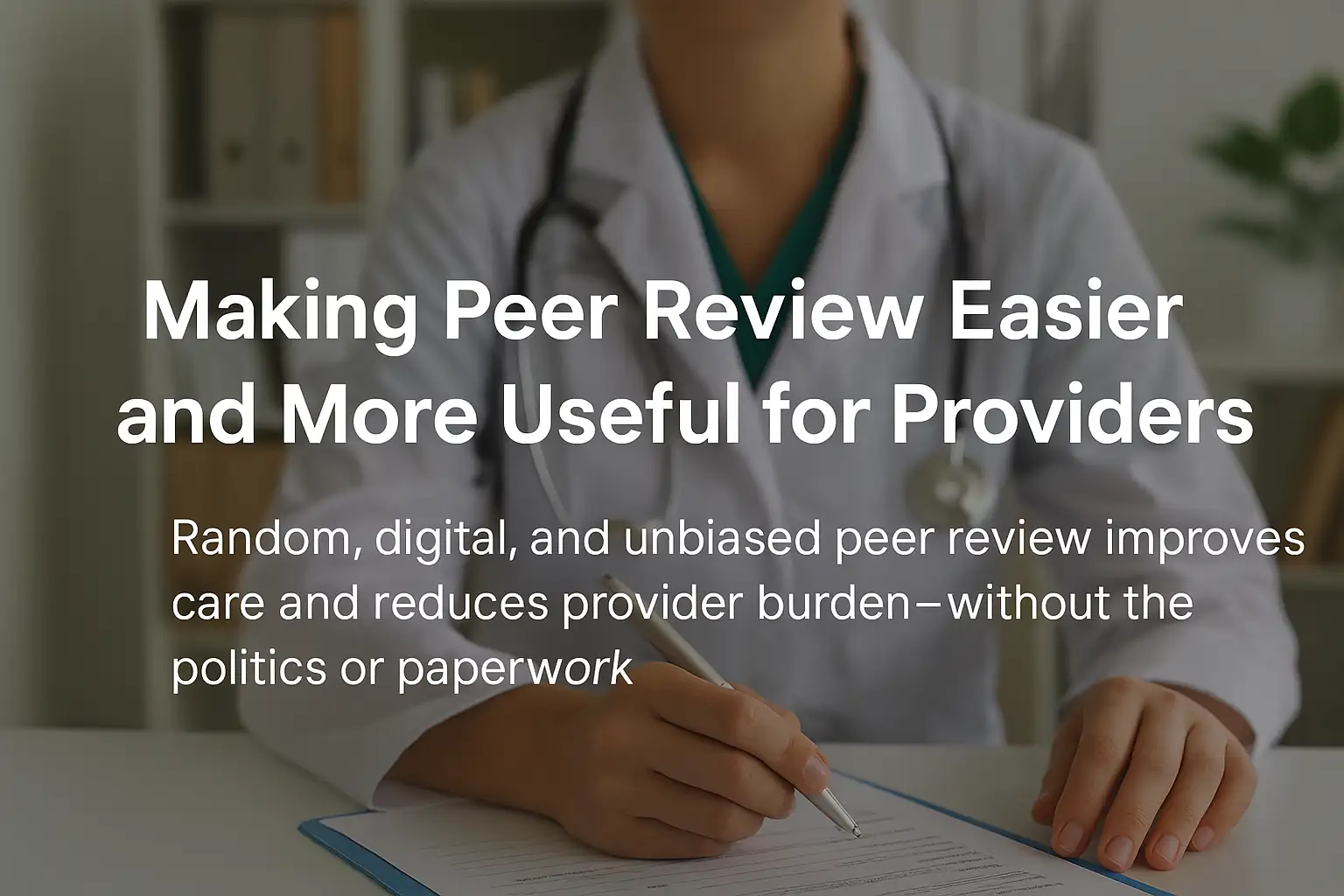
Table of Contents

Making Peer Review Easier and More Useful for Providers
Random, digital, and unbiased peer review improves care and reduces provider burden—without the politics or paperwork.
Peer review is a powerful tool for improving quality of care, but in too many settings, it feels like a burdensome checkbox exercise or worse, a punitive process that comes into play only after a harm event. For peer review to be truly effective and provider-friendly, it must be redesigned around ease, relevance, and fairness. Here are four ways to make peer review easier and more meaningful for your team.
1. Shift from Punitive to Proactive: Embrace Random Sampling
Traditional peer review often focuses on reviewing cases with adverse outcomes or complaints. While those cases need attention, they don't always provide a complete picture of how care is delivered. By contrast, selecting a random sample of patient encounters offers a more balanced and accurate view of everyday care.
Random sampling helps identify patterns of suboptimal care that might not yet have led to a harm event but could in the future. These patterns are precisely where organizations can intervene early to improve outcomes. When clinicians know their reviews aren't only triggered by bad news, they perceive the process as more constructive and less threatening.
2. Identify Suboptimal Patterns Before They Become Problems
A patient safety program that only investigates negative outcomes is always playing catch-up. Randomly selected reviews allow quality teams to detect subtle but consistent issues in documentation, decision-making, or communication that, if left unaddressed, could eventually lead to serious problems.
This approach is especially important in complex or high-risk environments, where even small variances in practice can have a big impact over time. By reviewing cases where everything seemingly went "fine," organizations can find hidden gaps in care and support ongoing education and process improvement.
3. Go 100% Digital and Ruthlessly Reduce Clicks
Many internal peer review systems suffer from poor adoption not because providers object to the concept, but because the process is clunky, paper-based, or time-consuming. A digital-first review platform that minimizes friction can transform engagement.
Think fewer logins, fewer clicks, fewer emails. Automate notifications, auto-fill reviewer info, and streamline the scoring and comment process. Every click you eliminate makes it more likely your reviewers will complete their tasks consistently and on time.
Integrating peer review directly into the tools clinicians already use, or providing a secure, lightweight web interface, ensures the process feels like a natural extension of their workflow, not a chore.
4. Use External Reviewers to Reduce Burden and Improve Fairness
Peer review, when done entirely internally, can place providers in the awkward position of judging their colleagues. In smaller settings or tight-knit teams, this dynamic can lead to tension, perceived bias, or even retaliation fears. Worse, it can create a culture of silence where no one wants to speak up.
Bringing in external reviewers eliminates these interpersonal dynamics and adds a layer of credibility to your quality program. Even outsourcing a portion of your reviews—say, one per provider per year—can dramatically reduce the burden on internal staff while helping surface unbiased, expert feedback.
External reviewers can also help maintain continuity in peer review processes during times of staffing turnover or leadership transitions.
Conclusion: Make Peer Review Work for You
Peer review should be a tool for support, learning, and continuous improvement—not just another box to check. By shifting the focus to random sampling, digitizing the process to reduce effort, and bringing in external perspectives, healthcare organizations can make peer review more useful for providers and more impactful for patients.
Done right, peer review becomes more than a compliance requirement. It becomes a catalyst for better care.

Mitigating Risk in Tribal Health: Proactive Patient Safety with Culturally Competent External Peer Review
External peer review offers Tribal Health Organizations unbiased, culturally competent assessments, reducing administrative burden, improving patient safety, and strengthening compliance documentation.
.png)
.png)

Value-Based Care for FQHCs: How External Peer Review Drives Better Outcomes and Sustainable Revenue
Medplace external peer review helps FQHCs thrive in value-based care. Gain objective insights, cut compliance risk, reduce admin burden, and boost quality, provider satisfaction, & revenue.
.png)
.png)

Addressing the Rural Workforce Shortage: Maintaining Quality of Care with Scalable External Peer Review
Combat rural healthcare shortages and maintain quality with scalable external peer review. Medplace offers objective, specialty-matched reviews, reducing burden and ensuring compliance.
.png)
.png)



.png)
.png)
.png)


.png)




.png)